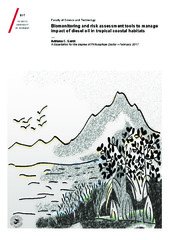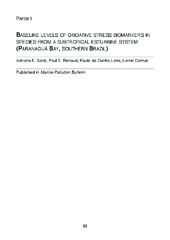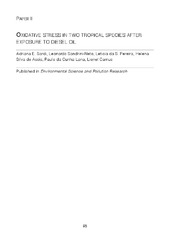| dc.contributor.advisor | Sydnes, Are | |
| dc.contributor.author | Sardi, Adriana Eva | |
| dc.date.accessioned | 2017-06-22T07:36:18Z | |
| dc.date.available | 2017-06-22T07:36:18Z | |
| dc.date.issued | 2017-05-05 | |
| dc.description.abstract | The focus of this work is in developing biology–based tools for environmental monitoring
and risk assessment associated with diesel oil contamination in tropical coastal habitats.
Prediction of impacts is generally conducted via environmental monitoring, in which environmental
quality over time and space is assessed by repeated observations. Prediction of risk is included
within the risk assessment process, which is the procedure that estimates the likelihood or the
actual adverse effects caused by anthropogenic activities on ecosystems. During the past decades,
oil production has increased, and so has the risk of oil pollution, either through produced water
discharges, accidents, or other diffuse sources. This risk is notably high in tropical and
subtropical areas, which represent around 60% of total global oil production. Petroleum is composed
of a mixture of various mono– and polycyclic–aromatic hydrocarbons, toxic chemicals consisting of
two or more fused benzene rings. The mode of action of PAHs is classified as narcotic, meaning that
PAHs are expected to penetrate cell membranes and alter the lipid bilayer, ultimately disturbing
the normal function of cells. On average, nearly 85% of the total petrogenic PAH input to the
marine environment origins from petroleum consumption or diffuse sources. Among marine coastal
habitats, tropical and subtropical coastal regions are home to speciose and highly productive
ecosystems. Estuaries are among the most productive of marine ecosystems and are areas with high
economic and ecological importance. Being economic centers for coastal communities that harvest
biotic resources, tropical and subtropical estuarine intertidal environments (i.e. mangroves, salt
marshes, and unvegetated tidal flats) are particularly susceptible to anthropogenic disturbance.
Specifically, chronic diesel oil contamination that leaks from marine vessels poses a real risk to
the species inhabiting the Paranaguá Estuarine System (PES) in southern Brazil, which host the
third largest harbor of Brazil, and receives around 200 ships per month. Oil contamination from
such diffuse sources, is an untraceable chronic source of contamination that can occur anywhere a
ship travels and may have different effects, depending on the physical–chemical characteristics of
the environment into which the oil is released. Therefore, tools for biomonitoring the effects of
short and long–term exposure to diffuse oil contamination are much needed. The general objectives
of this work are to validate the use of antioxidant biomarkers as tools for biomonitoring coastal
estuarine habitats in Brazil, as also to compare the sensitivity and risk assessment metrics from
species distributed from subtropical, temperate and Arctic regions exposed to a toxic PAH.
Biomarkers are defined as measures of exposure or effect expressed at the sub–organism
level (i.e. biochemical, cellular, physiological or behavioral) in taxa under environmental stress.
We proposed the use of antioxidant biomarkers as sub-lethal measures of exposure at the
sub-organism level. Before implementing antioxidant biomarkers in biomonitoring programs, several
conceptual and methodological issues needed to be addressed. Namely, it is important to determine
their basal levels of activity, to select an appropriate sentinel species for their measurement,
and to determine the best group of biomarkers for a multi–biomarker approach. Also, it is necessary
to establish a correlation between the presence of diesel oil contamination and the activity of
selected biomarkers. This work addresses these points, first by conducting a seasonal baseline of
biomarker values, and then by performing experimental manipulations both in the lab and the field.
Because the activity of antioxidant enzymes is involved in cell homeostasis, they are expected to
vary in relation to reproductive cycles, food availability, and environmental drivers. Thus an
initial screening in the activity of 5 different subtropical species was conducted at two seasons
(austral winter and austral summer) at two different locations that have different levels of
organic and PAH contamination. Then, experimental manipulations that tested the correlation between
the antioxidant response and diesel oil exposure were conducted. The first experiment characterized
the antioxidant biomarker response in two common species under laboratory conditions; while in the
second experiment, the antioxidant biomarker response in the clam species Anomalocardia flexuosa
was evaluated after chronic exposure to diesel oil in situ. The significant changes in the
biomarkers activities following exposure suggested a causal relationship between biomarkers and
diesel oil contamination, with the activities of GST and SOD being the most sensitive to
experimental manipulations. These cause–effect relationships indicate that it is possible to use
these biomarkers as tools in biomonitoring programs at PES. However, it was noticeable that natural
variability is a major confounding source of variation, which in our experiments was handled by
including appropriate control treatments for comparing the response from the experimental treatment
with that from natural conditions. As part of the outcomes of this work, a guiding framework for
selecting biomarkers and testing their causal relationship to contamination and specific
recommendations for designing experiments for biomonitoring purposes are provided. Briefly,
well–designed experiments have a clear hypothesis to test, for which the measurement of
environmental parameters at an adequate sampling intensity is feasible,
given financial and logistic constraints. The statistical power of the design must be
considered before starting sampling and the design should include spatial and temporal
variability. Regarding differences in risk assessment metrics following the exposure to 2–
Methylnaphthalene, our results indicate that No–Effect Concentration (NEC) values — concentration
thresholds use to assess species sensitivity to toxic exposure— were not significantly different
among the studied species and differences among regions were not identified. However, when defining
sensitivity as the time to observe an effect —a metric that includes the NEC and a toxicokinetic
parameter like the elimination rate— differences in sensitivity among regions were detected. In
summary, species from Arctic to subtropical regions have similar NEC thresholds, but the time they
need to reach that threshold varies, and this variation is related to taxonomy and trophic level.
Arctic species had on average shorter times for starting to show an effect, followed by subtropical
and finally temperate species. Our results suggest that assuming that species sensitivities from
Arctic, and temperate regions is sufficiently similar to those from subtropical regions might be
incorrect. We suggest that in in the search for metrics for safeguarding the marine ecosystem,
attention should not be given only to concentration thresholds. Concentration thresholds might be
providing assessors an inaccurate metric for species sensitivity, which
is ultimately underestimating the risk to marine and estuarine ecosystems. | en_US |
| dc.description.doctoraltype | ph.d. | en_US |
| dc.description.popularabstract | The risk of oil pollution, either through produced water discharges, accidents or other diffuse sources, has increased as the world’s economy has expanded. In this work, I evaluated the response of subcellular biochemical markers —biomarkers— as potential indicators of exposure to oil contamination and determined if tolerable concentration thresholds generated from temperate and Arctic species are applicable to the tropical region. For that, a baseline of biomarker values in different species was established and the response of biomarkers characterized in the lab and in the field following oil exposure. Differences in the response of biomarkers and in the species sensitivity to oil were identified. As part of the conclusions, I am proposing the best species and measures for biomonitoring purposes, and providing recommendations to adapt risk–assessments strategies for the Paranaguá Estuarine System, in Southern Brazil, a beautiful coastal system of economic and ecologic importance, home of very diverse habitats and exotic species. | en_US |
| dc.description.sponsorship | “Latin Amerika” research program of the Norwegian Research Council, attributed to Akvaplan-niva AS under the Project number 227180/H30. | en_US |
| dc.description | The papers III and IV of this thesis are not available in Munin. <br>
<br>
Paper III: Sardi, A. E., Renaud, P. E., Morais, G. C., Martins, C. C., Lana, P. C., Camus, L.: “Effects of an in situ diesel oil spill on oxidative stress in the clam Anomalocardia flexuosa”. (Manuscript). Published version available in <a href=https://doi.org/10.1016/j.envpol.2017.07.040> Environmental Pollution 2017, 230:891-901. </a>
<br>
Paper IV: Sardi, A. E., Augustine, S., Morais, G. C., Olsen G. H., Camus, L.: “Exploring species sensitivity to a model hydrocarbon, 2–Methylnaphthalene, using a process–based model”. (Manuscript). | en_US |
| dc.identifier.isbn | 978-82-8236-260-3 (trykt) og 978-82-8236-261-0 (pdf) | |
| dc.identifier.uri | https://hdl.handle.net/10037/11169 | |
| dc.language.iso | eng | en_US |
| dc.publisher | UiT Norges arktiske universitet | en_US |
| dc.publisher | UiT The Arctic University of Norway | en_US |
| dc.rights.accessRights | openAccess | en_US |
| dc.rights.holder | Copyright 2017 The Author(s) | |
| dc.rights.uri | https://creativecommons.org/licenses/by-nc-sa/3.0 | en_US |
| dc.rights | Attribution-NonCommercial-ShareAlike 3.0 Unported (CC BY-NC-SA 3.0) | en_US |
| dc.subject | VDP::Mathematics and natural science: 400::Zoology and botany: 480::Ecotoxicology: 489 | en_US |
| dc.subject | VDP::Matematikk og Naturvitenskap: 400::Zoologiske og botaniske fag: 480::Økotoksikologi: 489 | en_US |
| dc.title | Biomonitoring and risk assessment tools to manage impact of diesel oil in tropical coastal habitats | en_US |
| dc.type | Doctoral thesis | en_US |
| dc.type | Doktorgradsavhandling | en_US |


 English
English norsk
norsk


